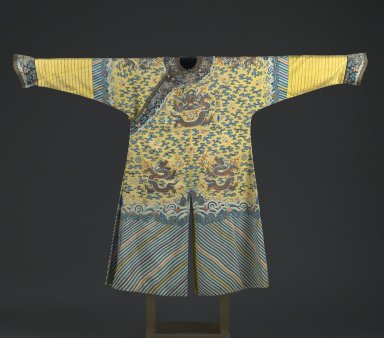
Medium: Silk kesa with silk embroidery and brass buttons
Geograhical Locations:
Dates:early 19th century
Dimensions: armpit to armpit: 26 3/8 x 55 1/2 in. (67 x 141 cm) Sleeve: 26 15/16 in. (68.5 cm)
Collections:
Accession Number: 34.1475
Image: 34.1475_front_PS6.jpg,
Catalogue Description: Emperor's sacrificial robe, made to open on the right side, fastened with four heave brass buttons and one frog, with not collar, but with long sleeves and cuffs shaped like a horse's hoof, and slit a little ways up from the bottom on the front and the back. K'ossu (tapestry) weave silk, a yellow ground designs chiefly in several shades of blue. The robe is decorated with five clawed dragons, three on the front, three on the back and two on the shoulders, flaming jewels, bats with swastikas or peaches, circular longevity characters and clouds. Scattered among the clouds are the Twelve imperial Symbols, the sun and the moon (on the shoulders), the constellation, the mountain, the dragons, the flowery bird, the cups, the water weed, the millet, the firs, the axe, and the symbol of distinction. On the sleeves above the elbow, just before the K'ossu gives way to a yellow plain cloth weave silk with bands of gold threads and around the bottom of the robe are wave and isle patterns strewn with the Eight Buddhist emblems of Happy Augury, and below, long wavy striations. The neck and the opening to below the right sleeve have bands of K'ossu weave silk, five clawed dragons with flaming pearls among clouds, bats, peaches and a wave pattern beneath, in colors on a dark blue ground. The cuffs are bound with a black plain compound weave silk, the extra gold warp threads of which make an all over geometric pattern. The coat is lined with a yellow plain cloth weave silk. The robe is torn in a few places on the neck and on the shoulders. Condition: faded but intact.